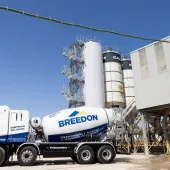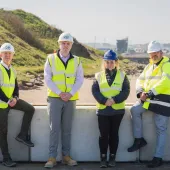UK’s first IBAA concrete laid at Ling Hall
The UK’s first concrete mix incorporating incinerator bottom ash aggregate (IBAA) has been laid at Veolia’s Ling Hall site in Warwickshire. The project, a collaboration between Breedon, Meldgaard, Recycl8, and Veolia, demonstrates how industrial by-products can replace virgin aggregates in concrete, reducing carbon emissions and supporting a circular economy.
The concrete, developed using Breedon’s mix design and Recycl8’s R8 Mix technology, was poured as an extension pad at Veolia’s IBA processing facility. Meldgaard, a specialist in recycling incinerator bottom ash (IBA), manages the production of secondary aggregates from waste processed at Veolia’s nearby Battlefield Energy Recovery Facility. The Ling Hall site produces 50,000 tonnes of IBAA annually, enabling a consistent supply of materials for innovative projects like this one.
“Processing bottom ash from non-recyclable waste gives us an important source of secondary aggregates,” said Donald MacPhail, CEO for treatment at Veolia. “This reduces reliance on virgin resources and cuts CO₂ emissions, which is vital as the UK uses 90 million tonnes of concrete each year.”
The Environment Agency approved the project, which highlights the environmental and practical benefits of using IBAA in concrete. While IBAA is commonly used in civil engineering under Regulatory Position Statement (RPS) protocols, this is the first instance in the UK of its use in bound concrete surfaces.
The concrete mix is designed to lower carbon emissions, saving approximately 30kg of CO₂ for every tonne of IBAA used. Recycl8’s R8 Mix enhances the material’s performance, ensuring it meets the demands of modern construction while supporting sustainability goals.

Mark Gillespie, managing director of Recycl8, emphasised the significance of the project: “This is a powerful example of how industrial by-products and innovative technology can drive greener construction. The Veolia Ling Hall project showcases a true circular economy, proving the strength and versatility of IBAA in real-world applications.”
Breedon’s regional manager Nick Farrell described the collaboration as a “game-changer,” adding: “This mix not only reduces reliance on traditional materials but also delivers a high-performance, low-carbon solution for the industry.”
Meldgaard’s UK IBA manager, Sarah Lakin, praised the initiative: “We’ve long seen the potential of IBAA as a sustainable alternative. Combining it with the R8 Mix demonstrates how this material can play a key role in low-carbon construction.”
The project also highlights the value of partnerships in advancing sustainable construction practices. “This collaboration aligns perfectly with our mission to develop solutions that lower environmental impact and help the industry achieve net zero targets,” said MacPhail.
The Ling Hall project is expected to pave the way for further testing and adoption of IBAA in concrete, providing a sustainable alternative to virgin aggregates and supporting the transition to a more circular construction industry.



